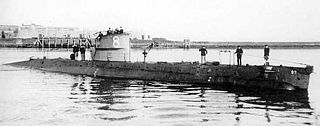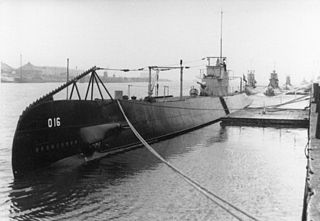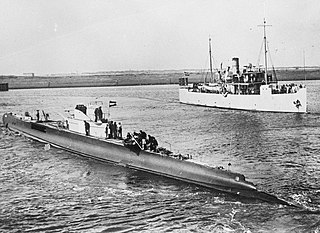
HMS H6 was a British H-class submarine of the Royal Navy built by Canadian Vickers & Co. during World War I.

HMS Sturgeon was an S-class submarine that entered service with the Royal Navy in 1932. Ordered in 1930, she was laid down at Chatham Dockyard in January 1931 and launched on 8 January 1932. Commissioned on 27 February 1933, Sturgeon was assigned to the 2nd Submarine Flotilla.

O 19, laid down as K XIX, was an O 19-class submarine of the Royal Netherlands Navy that saw service during World War II. O 19, along with her sister ship O 20, were the first submarines in the world to be equipped with a submarine snorkel that allowed the submarine to run its diesel engines while submerged.

HNLMS Marten Harpertszoon Tromp was a unique coastal defence ship of the Royal Netherlands Navy built by the Rijkswerf in Amsterdam.

HNLMS Jacob van Heemskerck was a unique coastal defence ship of the Royal Netherlands Navy built by the Rijkswerf in Amsterdam. She was among the ships send to patrol the Venezuelan coast during the Second Castro Crisis. After her active career she was rebuilt into a stationary battery ship and recommissioned. During World War II she was captured by the invading German forces and converted in an anti-aircraft battery. After the war the ship was recovered and given back to the Netherlands, to be converted to an accommodation ship.
HNLMS K XI was the first of three K XI-class submarines of the Royal Netherlands Navy, built to serve as a patrol vessel in the Dutch colonies.

HNLMS O 16 was a submarine of the Royal Netherlands Navy that saw service during World War II. She was the first submarine of the RNN manufactured from high-quality Steel 52, with the ability to dive at a depth of 80 metres (260 ft).

O 24, laid down K XXIV was an O 21-class submarine of the Royal Netherlands Navy that saw service during World War II. The most famous occupant of O-24 was Piet de Jong, who was the commanding officer from 1944 until 1946 and who later became Minister of Defence in 1963 and served as Prime Minister of the Netherlands from 1967 until 1971.

HNLMS O 12 was a O 12-class submarine of the Royal Netherlands Navy. Built at Koninklijke Maatschappij De Schelde in Vlissingen, she was launched in 1930 but was unable to take part in military action during World War II. After being scuttled by the Dutch Navy, she was raised by Nazi Germany's Kriegsmarine and taken into service as UD-2, and then scuttled again.

O 13 was an O 12-class submarine of the Royal Netherlands Navy that saw service during World War II. She was built by the Koninklijke Maatschappij De Schelde of Vlissingen. She was one of many Dutch ships doing convoy duty during the Spanish Civil War. At the time of the German invasion of the Netherlands, O 13 was on patrol off the Dutch coast and was attacked by German planes on multiple occasions. After fleeing to England, the submarine was lost during a patrol on the North Sea.

O 14 was a O 12-class submarine of the Royal Netherlands Navy that saw service during World War II. It was built by the Koninklijke Maatschappij De Schelde of Vlissingen and entered active duty on 4 March 1934.

O 1 was a Holland 7P patrol submarine of the Royal Netherlands Navy. The ship was built by the De Schelde shipyard in Flushing and was the first submarine in the Dutch navy. It had a diving depth of 25 metres.

UD-5 was an O 21-class submarine. The boat was laid down as the Dutch submarine HNLMS K XXVII and renamed HNLMS O 27 but was captured during the German invasion of the Netherlands in World War II and commissioned in the Kriegsmarine. The ship survived the war and was returned to the Netherlands where she served under her old name until 1959.
O 11 was a O 9-class patrol submarines of the Royal Netherlands Navy. The ship was built by Fijenoord shipyard in Rotterdam.
O 9 was an O 9-class patrol submarines of the Royal Netherlands Navy. The ship was built by Koninklijke Maatschappij De Schelde shipyard in Flushing.

O 10 was a O 9-class patrol submarines of the Royal Netherlands Navy. The ship was built by Nederlandsche Scheepsbouw Maatschappij shipyard in Amsterdam.

HNLMS Dolfijn was a Dolfijn-class submarine of the Royal Netherlands Navy.

K XVII was one of five K XIV-class submarines built for the Royal Netherlands Navy. She served during World War II.

K XVIII was one of five K XIV class submarines built for the Royal Netherlands Navy. She served during World War II.
















